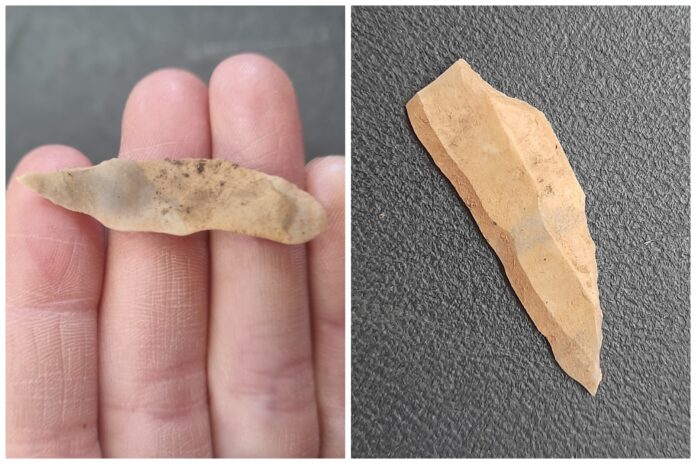Archaeologists have unearthed a set of “truly significant” Stone Age artifacts during an excavation being conducted ahead of planned road improvement in northern England, researchers told Newsweek.
The dig, which is taking place along the A66, a major road that runs west to east across the region connecting the counties of North Yorkshire and Cumbria, has already uncovered a wealth of remains from thousands of years of history.
The remains include a prehistoric settlement, a potential early medieval building and Roman-era artifacts, National Highways, a U.K.-government-owned body, in collaboration with the Oxford Cotswold Archaeology (OCA) partnership, announced in a press release at the end of February.
Now the archaeology team has revealed to Newsweek that during the dig, it uncovered a pit containing four prehistoric flint tools. The objects are of a type that were made and used across Europe in the Upper Paleolithic period (the third and last subdivision of the Paleolithic, or Old Stone Age), which covers the latter part of the last Ice Age. According to the archaeologists, the tools could possibly be anywhere from 10,000 to 14,000 years old.
Oxford Cotswold Archaeology
The Upper Palaeolithic finds are “truly significant, given the rarity of finds from this period,” Maria Bellissimo, a spokesperson for Oxford Archaeology (a charitable company that makes up one half of the OCA partnership with Cotswold Archaeology), told Newsweek.
The A66, in part, follows the course of an ancient Roman road from Scotch Corner to Penrith, although the roadway has an even longer history, having been in use for about 10,000 years.
“The route followed by the modern A66 through the Eden Valley and Stainmore Pass was ancient even when the Romans formalized it with their own road, nearly 2,000 years ago,” Stephen Rowland, project manager at Oxford Cotswold Archaeology, said in the February press release.
“Significant road and river junctions and crossings are still marked by prehistoric monuments, Roman forts and medieval castles, whilst the fertile valley has supported communities since the end of the last Ice Age,” he said.
The possible age of the recently revealed Upper Paleolithic finds places them in a time when the local conditions would have looked quite different than how they do now.
“The cold climate and tundra-like natural environment would have been rather different to those today and, whilst they’re popularly characterized as cave people, it’s likely that small communities led a fairly mobile existence, hunting and foraging,” Rowland, Helen Evans—another project manager for the excavations—and stone tool expert Antony Dickson told Newsweek.
“They would have followed herds of animals, such as reindeer, wild horses and the rather imposing wild cattle—beasts that migrated seasonally up and down the Eden Valley and into the Pennines [a range of uplands] via the Stainmore Pass that, as now, was a main link between northeast and northwest Britain.”
In fact, these people were likely to have been part of a wide-ranging culture, with Britain connected to continental Europe via an expanse of land that was later swamped as water from the melting Ice Age glaciers created the North Sea, according to the archaeologists.
“Several of the tools we found were points, which could well represent the business end of a hunting weapon. Not only are such finds rare in Cumbria, but it’s also unusual to find Upper Paleolithic artefacts in a man-made feature like a pit—more often they’ve been disturbed by thousands of years of weathering,” the researchers said.
“Indeed, the pit seems to have survived due to having been sealed by a deposit of soil washed down a slope; it’ll be interesting to expand that trench and see what else might have survived and whether the findings represent part of a larger encampment.”
The flint finds, along with the wide range of discoveries from later periods, are helping to shed light on the history of the region. And more discoveries are expected as the work continues.
“All the bits taken together really allow us to start piecing together a picture of this part of prehistoric Cumbria that is becoming clearer and clearer,” Bellissimo said.
“Do keep in mind that this phase of work was only the beginning and it was an evaluation to inform where larger excavations will take place in the next phase. We will probably start the next phase in the summer, so it is fair to expect more finds and more data. Until then, we will continue our research in the lab and over the next three to six months we will start receiving radiocarbon dates that will add even more detail.”
Do you have a tip on a science story that Newsweek should be covering? Do you have a question about archaeology? Let us know via [email protected].
Uncommon Knowledge
Newsweek is committed to challenging conventional wisdom and finding connections in the search for common ground.
Newsweek is committed to challenging conventional wisdom and finding connections in the search for common ground.


